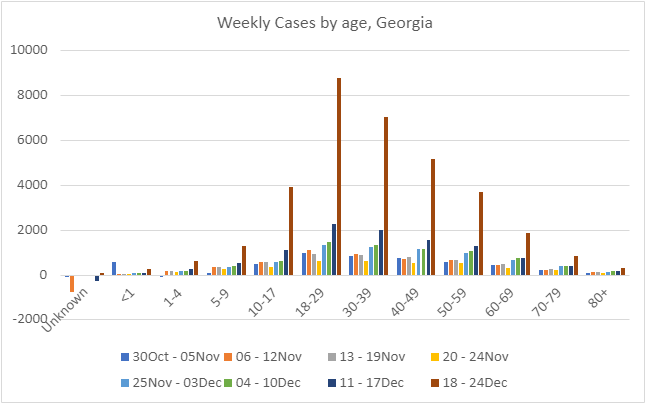I was on a flight to Hawaii when the news broke that Omicron was now 73% of US COVID-19 specimens that were sent for sequencing. We had already postponed this trip in September to wait for pediatric vaccines. We were a fully vaccinated pandemic family (4 adults, four kids) with all adults boosted. We had our KN-95 masks and sanitizer. We were taking precautions. With Omicron looming on the horizon, it felt like a bit of a “now or never” kind of situation. The most dangerous part of our vacation would be the day of airplane travel itself, since all of our planned activities and dining plans were taking place outside.
So there I was, over the Pacific, checking the latest data upload from Georgia Department of Public Health when my inbox started blowing up with alerts from friends and followers about Omicron. Reporters were pinging me for interviews. I could also see that cases and COVID-19 patient census were rising dramatically for the Georgia and now for Hawaii too. If we had heard this news one day sooner, my family wouldn’t have even gotten on the airplane. But there I was, surrounded by people, on a flight to Honolulu.
We’ve been here for four days and still test negative. I will note that Hawaii takes the virus so much more seriously than Kansas City, where I live. You have to have proof of vaccination to enter restaurants, museums, hotels, etc. It just feels safer to eat in restaurants, knowing that people went through that check. But thankfully, most restaurants in Hawaii are open-air anyway and we take full advantage of that.
So let’s talk about what’s going on with COVID-19. The bad news is that Omicron is driving cases skyward in multiple parts of the country, including Georgia. Since Georgia is home, it’s getting special focus in today’s newsletter. I wasn’t planning to write this week due to the holiday but with cases exploding in Georgia it feels very much like I need to send this update.
The most important data I want to show you are what’s happening with age groups with respect to cases and hospitalizations. First, let’s look at weekly case totals (PCR test identified only) for the past 8 weeks by age groups.
You can see that cases are rising dramatically across multiple age groups. In fact, they make more recent case totals look tiny by comparison. 18-29 year olds lead the case increase, as they have in all previous surges other than Delta. Now look what’s happening with hospital admissions for COVID-19, because it is very different than what we’ve observed in the past.
Usually, we see that cases and hospitalizations trend together statewide, but the hospitalizations are usually skewed to the right on this graph, peaking over those 60-69. But this time we are seeing a dramatic rise in hospital admissions for COVID-19 among young adults - aged 18-39. This could be due to lower vaccination rates among young adults than their older counterparts. But regardless, this is a really stunning rise in hospital admissions for young adults. I would just caution people to not confuse youth with invincibility. These are people who are not only sick, but sick enough that they need to be admitted to a hospital.
The rest of today’s newsletter focuses on some of the other important metrics for Georgia.
Keep reading with a 7-day free trial
Subscribe to The COVID Digest to keep reading this post and get 7 days of free access to the full post archives.





